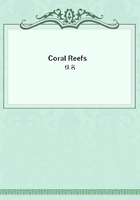
第49章
Such cases, however, are open to some doubts, for an old fringing-reef, which had extended itself a little on a basis of its own formation, would hardly be distinguishable from a barrier-reef, produced by a small amount of subsidence, and with its lagoon-channel nearly filled up with sediment during a long stationary period. Between barrier-reefs, encircling either one lofty island or several small low ones, and atolls including a mere expanse of water, a striking series can be shown: in proof of this, I need only refer to the first plate in this volume, which speaks more plainly to the eye, than any description could to the ear. The authorities from which the charts have been engraved, together with some remarks on them and descriptive of the plates, are given above. At New Caledonia (Plate II., Figure 5.) the barrier-reefs extend for 150 miles on each side of the submarine prolongation of the island; and at their northern extremity they appear broken up and converted into a vast atoll-formed reef, supporting a few low coral-islets: we may imagine that we here see the effects of subsidence actually in progress, the water always encroaching on the northern end of the island, towards which the mountains slope down, and the reefs steadily building up their massive fabrics in the lines of their ancient growth.
We have as yet only considered the origin of barrier-reefs and atolls in their simplest form; but there remain some peculiarities in structure and some special cases, described in the two first chapters, to be accounted for by our theory. These consist--in the inclined ledge terminated by a wall, and sometimes succeeded by a second ledge with a wall, round the shores of certain lagoons and lagoon-channels; a structure which cannot, as I endeavoured to show, be explained by the simple growing powers of the corals,--in the ring or basin-like forms of the central reefs, as well as of the separate marginal portions of the northern Maldiva atolls,--in the submerged condition of the whole, or of parts of certain barrier and atoll-formed reefs; where only a part is submerged, this being generally to leeward,--in the apparent progressive disseverment of some of the Maldiva atolls,--in the existence of irregularly formed atolls, some being tied together by linear reefs, and others with spurs projecting from them,--and, lastly, in the structure and origin of the Great Chagos Bank.
STEP-FORMED LEDGES ROUND CERTAIN LAGOONS.
If we suppose an atoll to subside at an extremely slow rate, it is difficult to follow out the complex results. The living corals would grow up on the outer margin; and likewise probably in the gullies and deeper parts of the bare surface of the annular reef; the water would encroach on the islets, but the accumulation of fresh detritus might possibly prevent their entire submergence. After a subsidence of this very slow nature, the surface of the annular reef sloping gently into the lagoon, would probably become united with the irregular reefs and banks of sand, which line the shores of most lagoons. Should, however, the atoll be carried down by a more rapid movement, the whole surface of the annular reef, where there was a foundation of solid matter, would be favourably circumstanced for the fresh growth of coral; but as the corals grew upwards on its exterior margin, and the waves broke heavily on this part, the increase of the massive polypifers on the inner side would be checked from the want of water. Consequently, the exterior parts would first reach the surface, and the new annular reef thus formed on the old one, would have its summit inclined inwards, and be terminated by a subaqueous wall, formed by the upward growth of the coral (before being much checked), from the inner edge of the solid parts of the old reef. The inner portion of the new reef, from not having grown to the surface, would be covered by the waters of the lagoon. Should a subsidence of the same kind be repeated, the corals would again grow up in a wall, from all the solid parts of the resunken reef, and, therefore, not from within the sandy shores of the lagoon; and the inner part of the new annular reef would, from being as before checked in its upward growth, be of less height than the exterior parts, and therefore would not reach the surface of the lagoon. In this case the shores of the lagoon would be surrounded by two inclined ledges, one beneath the other, and both abruptly terminated by subaqueous cliffs. (According to Mr. Couthouy (page 26) the external reef round many atolls descends by a succession of ledges or terraces. He attempts, I doubt whether successfully, to explain this structure somewhat in the same manner as I have attempted, with respect to the internal ledges round the lagoons of some atolls. More facts are wanted regarding the nature both of the interior and exterior step-like ledges: are all the ledges, or only the upper ones, covered with living coral? If they are all covered, are the kinds different on the ledges according to the depth? Do the interior and exterior ledges occur together in the same atolls; if so, what is their total width, and is the intervening surface-reef narrow, etc.?)
THE RING OR BASIN-FORMED REEFS OF THE NORTHERN MALDIVA ATOLLS.